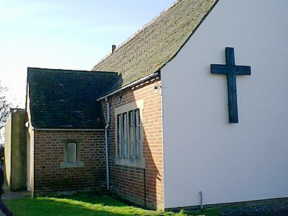

|
Eastington Methodist Church |
|
|
|
Click Here for the latest Edition of PewsNews to see what is happening now! |
|
The following is taken from a booklet produced at the time the main church building was demolished in 1975. (This document has been scanned in some OCR induced errors may still be present.) A lot has happened since 1975 and will hopefully be written up in due course. EASTINGTON METHODIST CHURCH 1800 - 1975 A Short History by L.C. Elsdon At a time when exciting, challenging moves are afoot for the Methodists of Eastington it would seem appropriate to search out and document as much of the history of the cause as is possible. From a number of sources it is clear that there were a group of people meeting in the name of the Lord and under the banner of Methodism even while the Wesley’s themselves were taking the message to every part of the land in Word and Song. There is no known record of John Wesley visiting Eastington though his Journals show that he visited in this part of the land. His early follower, Whitefield, bad definite connections with Stonehouse and we have clear records of his preaching there and attracting large crowds. The Victoria History for Gloucestershire mentions that one or two houses in Eastington were recognised as meeting places for Methodists before 1800, and as early as 1788 a piece of land was purchased on which stands the house which is still called ‘The Manse’. Although the Manse is no longer owned by the Church, part of the original piece of land is still in the possession of the Circuit and is known in Methodist Circles as ‘The Circuit Garden’ and is let to two tenants as garden ground. In 1808 the first church was built on that site and served a thriving cause until 1870. Part of the work of this fellowship was concerned with running a large and flourishing Sunday School. In those far off days it was customary for the Sunday School to organise classes in reading on other days of the week too and so it was that the church extended their grounds westward by buying a bit of land 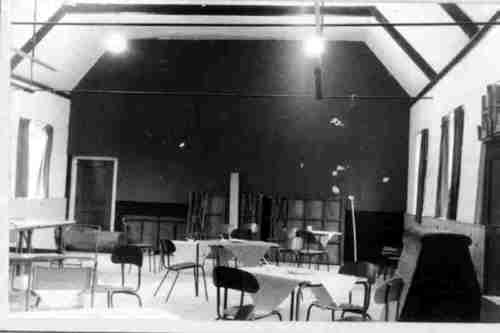 from Messrs. T. & E. Ricketts. In 1858 a schoolroom to be used for
both Sunday School and day school was built at a cost of £700. In 1871 there
were 64 scholars in the school with an average attendance of 42. Emily Davey
was the teacher and her salary was £57.12.0d. a year made up from ‘Childrens
Pence, Government Grant and Subscriptions’. The earliest registers were surrendered
to Somerset House but the earliest Baptismal register goes back to 1859
and contains names such as Clutterbuck, Bennett, Warner, Ford, Gwinnell,
Miles, Davies; many of which are still familiar names in the village today.
This 1858 building is the one which is now being adapted for use as a Place
of Worship as well as a ‘Friendship Centre’ for general purposes. So the
wheel turns full circle and soon we hope that both Sunday and weekday activities
will once again flourish in the Hall which was originally built for just
that purpose.
from Messrs. T. & E. Ricketts. In 1858 a schoolroom to be used for
both Sunday School and day school was built at a cost of £700. In 1871 there
were 64 scholars in the school with an average attendance of 42. Emily Davey
was the teacher and her salary was £57.12.0d. a year made up from ‘Childrens
Pence, Government Grant and Subscriptions’. The earliest registers were surrendered
to Somerset House but the earliest Baptismal register goes back to 1859
and contains names such as Clutterbuck, Bennett, Warner, Ford, Gwinnell,
Miles, Davies; many of which are still familiar names in the village today.
This 1858 building is the one which is now being adapted for use as a Place
of Worship as well as a ‘Friendship Centre’ for general purposes. So the
wheel turns full circle and soon we hope that both Sunday and weekday activities
will once again flourish in the Hall which was originally built for just
that purpose.In the late 1860’s the original chapel in the ‘Circuit Garden’ was becoming rather dilapidated and unsafe and so it was that a new, large and very adequate chapel was built abutting onto the end of the schoolroom and running out towards the Alkerton/Claypits road on a plot of ground bought from one Charles Warner of Horsley. This chapel was designated a ‘Wesleyan Methodist’ chapel and the stone - laying ceremony was performed on the 7th July, 1869. It was opened for worship on the 7th July, 1870. This was a brick-built edifice with stone corners and window surrounds, the windows being full length and round headed. It had a commodious gallery and was furnished with 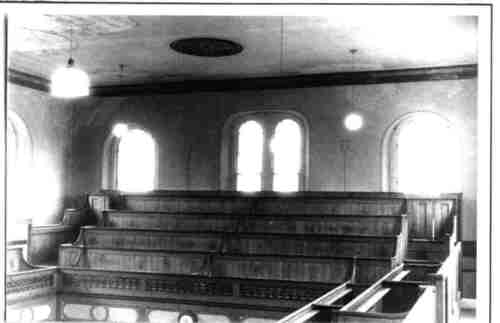 built-in pinewood pews — each one numbered and complete with its own door
so that “when you were in you were in” • The first baptism in this chapel
was James Thomas Miles and the names of some of the officers of the Church
at this time include :—
built-in pinewood pews — each one numbered and complete with its own door
so that “when you were in you were in” • The first baptism in this chapel
was James Thomas Miles and the names of some of the officers of the Church
at this time include :—H. Mayo: E. Warner: F. Warner: Barnfield: Hayward: Bennett. At first the pulpit was of stone but later this was replaced by a very nice pinewood pulpit in keeping with the rest of the furnishings. At the time of writing (1975) much of the 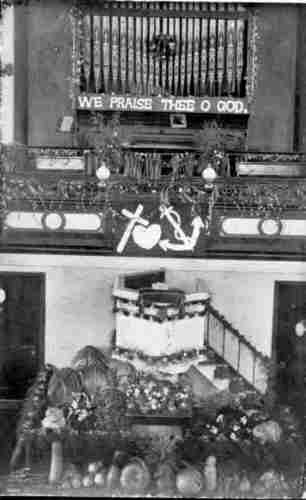 original stone pulpit can be seen in ‘The Manse’ garden next door. In 1897
(Queen Victoria’s Jubilee Year) the fine Pipe Organ which served the chapel
until it closed in 1975, was purchased from Rycroft Street chapel in Gloucester
for £70 plus removal expenses. An electric blower was talked about at Leaders
Meeting in June 1945 and work was started on raising the necessary £60 but
the exact date of the introduction of this modern amenity does not seem
to be recorded. When the chapel closed in 1975 a new home was found for
the organ - it went almost back home to the parish church of St. Barnabas,
Tuffley. In return St. Barnabas sent Eastington a cheque for £50 so the
depreciation after 78 years of use amounted to £20. Owing to the change
in the value of money however, this figure really does not mean a thing.
This change in values is even more clearly illustrated by a look at the
cost of building the chapel in 1870 — £1,062. 3s. l0d. and a figure almost
double that for demolishing the building, in 1975. It is interesting to
note that in 1870 the chapel was opened FREE FROM DEBT. The local mill-owner,
Mr. C.H. Hooper, was a keen supporter of the cause and was of considerable
help in achieving this admirable state of affairs. There are those still
alive today who can remember when the girls who worked at the mill were expected
to attend chapel every Sunday and had to produce their Star Cards on Monday
to prove it. Looking even further back to the original building we find the
cost of that one was £750 (in 1808) but we have no information as to what
kind of a building that was though it must-have been of a useful size as
the Victoria History gives us the information that there were 152 children
on the Sunday School roll in 1833.
original stone pulpit can be seen in ‘The Manse’ garden next door. In 1897
(Queen Victoria’s Jubilee Year) the fine Pipe Organ which served the chapel
until it closed in 1975, was purchased from Rycroft Street chapel in Gloucester
for £70 plus removal expenses. An electric blower was talked about at Leaders
Meeting in June 1945 and work was started on raising the necessary £60 but
the exact date of the introduction of this modern amenity does not seem
to be recorded. When the chapel closed in 1975 a new home was found for
the organ - it went almost back home to the parish church of St. Barnabas,
Tuffley. In return St. Barnabas sent Eastington a cheque for £50 so the
depreciation after 78 years of use amounted to £20. Owing to the change
in the value of money however, this figure really does not mean a thing.
This change in values is even more clearly illustrated by a look at the
cost of building the chapel in 1870 — £1,062. 3s. l0d. and a figure almost
double that for demolishing the building, in 1975. It is interesting to
note that in 1870 the chapel was opened FREE FROM DEBT. The local mill-owner,
Mr. C.H. Hooper, was a keen supporter of the cause and was of considerable
help in achieving this admirable state of affairs. There are those still
alive today who can remember when the girls who worked at the mill were expected
to attend chapel every Sunday and had to produce their Star Cards on Monday
to prove it. Looking even further back to the original building we find the
cost of that one was £750 (in 1808) but we have no information as to what
kind of a building that was though it must-have been of a useful size as
the Victoria History gives us the information that there were 152 children
on the Sunday School roll in 1833.As the work of education developed over the years the Day School had its up’s and down’s. In 1875 the Wesleyan Schoolroom applied to become a ‘Public Elementary School’ and then in 1879 the day-school work was removed to a room near the National School (near the Parish Church) though the official merger of the two was delayed until 1897. Even then the road ahead was not always smooth for we can read of a rift between the Schoolmaster and the Rector over the matter of compulsory attendance at Church and this lasted until the Rector resigned the living in 1902. ‘The Manse’ was built at around the same time as the first chapel (1808) and the first resident minister (Wm. Dixon) was then appointed. At the time the second chapel was built (1870) the Minister was a Reverend Samuel Wesley (no relation to the founders of Methodism). Mr. Wesley and his family were very popular and much loved by the members and we are told that when be left at the end of three year’s ministry “many people left their work in order to bid them farewell and watch their departure”. No doubt Mr. Wesley had played a large part in the adventurous step of building a new chapel. He preached the last sermon in the old building on 3rd July, 1870, and the new chapel was opened on 7th July, 1870, when the Reverend S. Coley preached on the words ‘Jesus only’. The Reverend S. Wesley left Eastington later the same year. The Manse was eventually sold just before the end of the last Century and oversight of the work at Eastington became the responsibility of the Minister living at Stonehouse or Cam and more recently at Dursley. 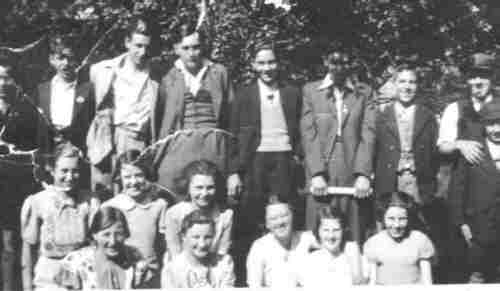 About 1908 the chapel was extensively renovated - the only major work
undertaken in the present Century until coal-fired central heating was installed
about 1938 to take the place of the two old ‘tortoise’ stoves. During the
second world war (1939—45) services were for a time held in the schoolroom
as the long windows in the chapel were difficult to ‘black out’. Later the
services moved back into the chapel after blinds bad been fitted, as the
schoolroom was taken over by the War Agricultural Executive Committee as
a Hostel for a succession of temporary agricultural workers.
About 1908 the chapel was extensively renovated - the only major work
undertaken in the present Century until coal-fired central heating was installed
about 1938 to take the place of the two old ‘tortoise’ stoves. During the
second world war (1939—45) services were for a time held in the schoolroom
as the long windows in the chapel were difficult to ‘black out’. Later the
services moved back into the chapel after blinds bad been fitted, as the
schoolroom was taken over by the War Agricultural Executive Committee as
a Hostel for a succession of temporary agricultural workers.In May 1950 the Sunday School celebrated its 150th Anniversary with Special Services on the 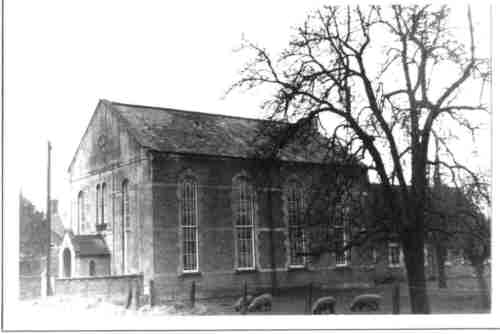 Saturday and Sunday, May 20th and 21st. Pastor David Bennett was in charge
of the work at this time and he conducted the special Childrens Service
on the Sunday afternoon while the preacher at the morning and evening services
was the Rev. H.B. Cowl, M.C. We are further informed that the Rev . Clifford
Hunt received three young people into membership on Good Friday morning.
(The names are bound to mean something to someone so here they are - Judith
Broomhall, Gwyneth Davies, and David Fowler). At this time the membership
stood at 42. On Sunday April 30th, the same minister baptized
Saturday and Sunday, May 20th and 21st. Pastor David Bennett was in charge
of the work at this time and he conducted the special Childrens Service
on the Sunday afternoon while the preacher at the morning and evening services
was the Rev. H.B. Cowl, M.C. We are further informed that the Rev . Clifford
Hunt received three young people into membership on Good Friday morning.
(The names are bound to mean something to someone so here they are - Judith
Broomhall, Gwyneth Davies, and David Fowler). At this time the membership
stood at 42. On Sunday April 30th, the same minister baptizedEdwin Charles, son of Mr. & Mrs. S. A. Edwards. and Christine Mary, daughter of Mr. & Mrs. L.W. Miles. In this most recent quarter-century (1950—1975), numbers have been continuously decreasing both with regard to adult membership and Sunday School scholars. A study of the old Minute 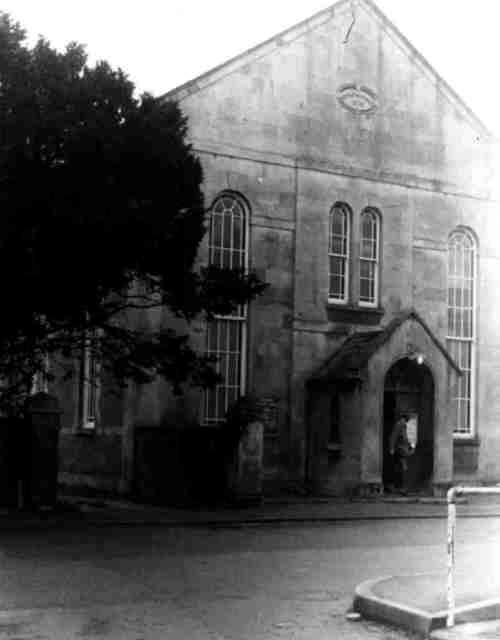 Books for these years brings out a number of factors about the life of
the fellowship. There has never been a lack of problems. In 1952 we read
in the Minutes of one meeting “The Business was concerned mainly with finance”,
and in many pages of the Minute Books this same concern is mentioned. Numbers
were falling - 43 members in November 1950: 30 in November 1954: then for
a number of years the number wavered at just above or just below 30, then
gradually decreased until the low mark of 15 was reached in 1974. Various
expedients were tried to stem the tide with Special Services, house visitation,
etc., but nowhere is there any evidence of a revival - even a campaign by
visiting Deaconesses and another by a Cliff College team seem to have been
abortive. In January 1955 a joint meeting of Trustees and Leaders expresses
“Concern at the financial and Spiritual condition of the Society”. The now
infamous roof came into the picture at this period and in June
Books for these years brings out a number of factors about the life of
the fellowship. There has never been a lack of problems. In 1952 we read
in the Minutes of one meeting “The Business was concerned mainly with finance”,
and in many pages of the Minute Books this same concern is mentioned. Numbers
were falling - 43 members in November 1950: 30 in November 1954: then for
a number of years the number wavered at just above or just below 30, then
gradually decreased until the low mark of 15 was reached in 1974. Various
expedients were tried to stem the tide with Special Services, house visitation,
etc., but nowhere is there any evidence of a revival - even a campaign by
visiting Deaconesses and another by a Cliff College team seem to have been
abortive. In January 1955 a joint meeting of Trustees and Leaders expresses
“Concern at the financial and Spiritual condition of the Society”. The now
infamous roof came into the picture at this period and in June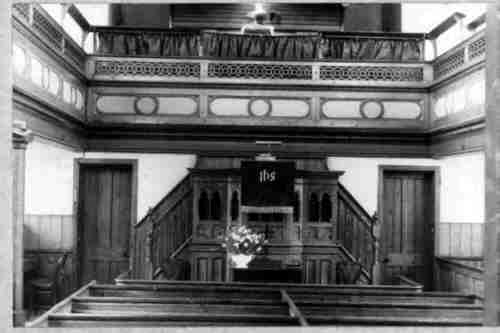 1955 an estimate for £73 for repairs was accepted in spite of “a balance
in hand of £4.10s.” Who said faith was a forgotten quality? From here on
this roof problem was constantly rearing its ugly head. Through all these
trials and tribulations the small group of loyal members displayed an indomitable
spirit and again and again they accepted the challenge and refused to give
up. They raised money constantly and we can find records of £46 from a Bazaar
in 1956: £82 10s. in 1957: and £95 from a Gift Day in 1964 - to mention
just a few.
1955 an estimate for £73 for repairs was accepted in spite of “a balance
in hand of £4.10s.” Who said faith was a forgotten quality? From here on
this roof problem was constantly rearing its ugly head. Through all these
trials and tribulations the small group of loyal members displayed an indomitable
spirit and again and again they accepted the challenge and refused to give
up. They raised money constantly and we can find records of £46 from a Bazaar
in 1956: £82 10s. in 1957: and £95 from a Gift Day in 1964 - to mention
just a few.At the same time, in spite of all their domestic worries, it appears that the small band of Eastington Methodists could always be counted on to take a wider view of their responsibilities as Christians 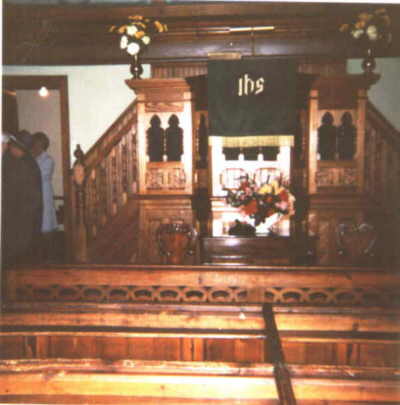 and we read of such things as - a donation to the Circuit Scooter fund;
a special effort for furniture for the now Manse at Dursley: the building
of the Stonehouse Church (1955); and Manse (1964) Home Missions Fund: regular
Christmas Gifts to old and less able members; a bus to bring the ‘Willows’
people to Hymn Services; and so on. It appears quite clear the Eastington
Society has never been too self centred in spite of a history of struggle
which might have given them an excuse for so being. What they seem to have
lacked most of all is some dynamic leadership and this is probably partly
due to the fact that for many years now the Minister in charge has lived
elsewhere and had other commitments.
and we read of such things as - a donation to the Circuit Scooter fund;
a special effort for furniture for the now Manse at Dursley: the building
of the Stonehouse Church (1955); and Manse (1964) Home Missions Fund: regular
Christmas Gifts to old and less able members; a bus to bring the ‘Willows’
people to Hymn Services; and so on. It appears quite clear the Eastington
Society has never been too self centred in spite of a history of struggle
which might have given them an excuse for so being. What they seem to have
lacked most of all is some dynamic leadership and this is probably partly
due to the fact that for many years now the Minister in charge has lived
elsewhere and had other commitments.During all this time the Sunday School work had been maintained until a few years ago. At the time of the 150th Anniversary in 1950 (which is mentioned elsewhere) the Sunday School Roll listed 59 children with an average attendance of 34. From time to time after this, mention is made in the Minutes of the Sunday School Staff meetings of the difficulty of finding teachers and whenever a member of the staff left there was a gap left behind which seemed almost impossible to fill. This difficulty increased as time went on and, apart from some short time help from the full-time youth leader around 1963/ 66, Miss Kathleen Shill was struggling on her own until even she was forced to give up the battle a few years ago. Sunday Services were cut down to one per Sunday in the latter years of this period. Numbers were very small and the cost of maintaining the building was increasing all the time. Electric heating was substituted for the old coal boiler but still the costs were prohibitive. In conjunction with the Youth Department of the County Education Committee a Youth Project was started in the early 60’s and made use of the schoolroom under the leadership of a full-time youth leader whose services were shared with Leonard Stanley. This did not, however, lead to the hoped for influx of young members into the Church though it was a useful service by the Church for the local community. It did lead to the addition of toilets to the Hall and the fitting out of a small kitchen and coffee bar. Finding the right leadership for the youth club was still a problem and the club closed down for the time being in 1974. The small group of loyal members had been worrying in respect of the roof which was becoming more and more vulnerable (through age) to the ravages of storm damage. After much prayer and heart searching and many meetings in the Church it was finally decided by the members that steps should be taken to convert part of the schoolroom into a Place of Worship and pull down the 1870 chapel. Many people were greatly distressed at the thought of demolishing a building which had meant so much to so many for so long, but even the longest - serving members realised that it was the only thing to do. Mercifully, they saw the move as a challenge and a great opportunity to start afresh and build up the work of God through Methodism in the village - this work was seen to be much more important than a building which was too big for the present day needs and which they could no longer afford. It is interesting to note here - as an aside- that the loudest lamentations 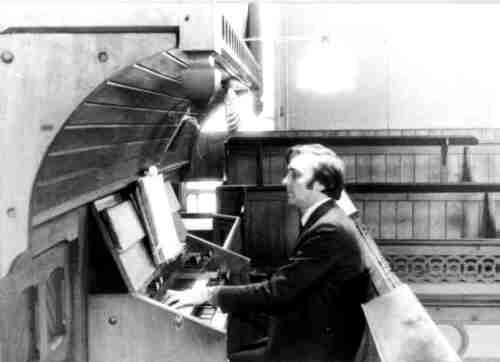 about the closure of the building came from people who had not seen the
inside of the chapel for some considerable time where as faithful regulars
accepted the move as a challenge to continue the work in spite of the difficulties.
The 105 years of the chapel were brought to a close with an organ recital
on Saturday 18th January, 1975, and the last service was held the following
day when our Anglican friends joined us for a service led by our Minister,
Rev. Gordon Gatward and the Rector, Rev. J. Green.
about the closure of the building came from people who had not seen the
inside of the chapel for some considerable time where as faithful regulars
accepted the move as a challenge to continue the work in spite of the difficulties.
The 105 years of the chapel were brought to a close with an organ recital
on Saturday 18th January, 1975, and the last service was held the following
day when our Anglican friends joined us for a service led by our Minister,
Rev. Gordon Gatward and the Rector, Rev. J. Green.The coffee lounge in the schoolroom was adapted for temporary use until the alterations at the other end of the Hall could be completed and members were much encouraged by the fact that the size of the congregation increased (slightly) immediately. The needs were made known throughout the District and the whole Connexion and help came from many sources. The other churches in the circuit gave financial help; the Chairman of the District (Rev. L.M. Wollen) was most helpful gathering help from here and there throughout the District;, and the Property Committee at Manchester were a great help. A ‘Gift Day’ at the end of 1974 had proved very successful and raised a little over £300 for the project and at the same time aroused much interest in the village. In the 1975 project of adapting the schoolroom as a Place of Worship, advice was given by Mr. Bob Burford, a friend of Mr. Gatward. The actual work was entrusted to a local builder, Mr. C.J. Kennedy of Claypits who proved to be very understanding and sympathetic to the work. Some measure of economy and a certain amount of continuity was achieved at one stroke by saving everything possible from the chapel building for use in the adaptations in the Schoolroom. Thus, backs of pews became panels in the new partitions; the pulpit and communion rail were fitted into the new scheme; roof rafters became supporting timbers for the partitions and for the false ceiling; and the many nice pieces of furniture accumulated over the years were carefully retained. Many of those latter items had been given in memory of members from various eras in the past and those will be found listed elsewhere in this booklet for the benefit of members of the future. One enterprising member even saved a few of the very large 105 year old nails from the demolished roof and turned them into symbolic crosses some of which may become family heirlooms and thus assist in this matter of continuity. As the recipients of those crosses each gave a donation in return the finances also benefited. Certain pews, not required for alternative use in the new chapel were taken away by members for use as garden seats etc. and again the donations given in return for these helped the finances. As a further contribution to the matter of continuity, the re-dedication and opening of the new chapel was arranged for the weekend of July 6th/7th, 1975, thus falling on the exact anniversary of the opening (and the Stone Laying) of the 1870 Chapel. The two Circuit Ministers (Revs. L.R. Edwards, and G.J. Gatward) were supported by the presence of a number of other Ministers and Clergy from the area and representatives of other churches in the Circuit and the Special Preacher for the opening service was Rev. Thomas G. Wilkinson, B.A., who had been stationed at Stonehouse in 1956 and is now on the staff of Millfield School at Street in Somerset. This short history is written by an ‘in-comer’ not only as a record of Methodism in Eastington but also as a tribute to the ‘never say die’ attitude of the small group of loyal people who have kept the cause alive in the village in spite of many problems — and sometimes very little encouragement from sources where encouragement might have been expected. Their names will not be recorded here and may not live for ever but their spirit will have an influence on the life of the area beyond their wildest dreams. For such people we PRAISE GOD. xxxxxxxxxx
Circuits Relationships over the years. 1800 — 1864 Dursley 1864 — 1885 Stonehouse and Eastington 1885 — 1888 Stroud 1888 — 1910 Stonehouse and Eastington 1910 — 1928 Mid-Gloucester Mission 1928 — 1936 Stonehouse 1936 — to date Dursley and Stonehouse It is interesting to note that in the early days of the Society (1809) the Dursley Circuit covered Societies at Dursley, Eastington, Wotton, Berkeley, Coaley, Nibley, Nimpsfield, Uley, Kingswood, Wickwar, Stanley, Whitminster, Slimbridge, Breadstone, Saul and Arlingham. (16) When the chapel just demolished was built (1870) the Stoneheuse and Eastington Circuit was comprised of Stonehouse, Eastington, Stanley, Horsley, Saul and Arlingham. (6) At the time of going to press (1975) the Dursley and Stonehouse Circuit is comprised of Dursley, Stonehouse, Cam, Wotton, Leonard Stanley, Eastington and Halmore. (7) |
|
|
|
|
|
Eastington Methodist Church is part of the Stroud & Dursley Circuit |
|
|
Services | Activities | Youth | Children | What's it all about? | Contacts | Useful Links | Location | |
|
|
This document maintained by
ken.burgin@EastingtonMethodists.org.uk
. |
|